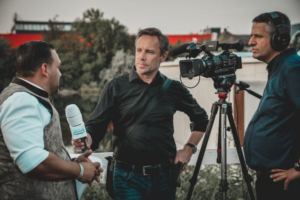Auteur theory? You must’ve probably heard of it before, at least in reference. You might even have a viewpoint on whether or not particular filmmakers are auteurs. What about Paul Thomas Anderson? Yes. Judd Apatow? Most likely not. Uwe Boll? Strangely, possibly. Auteur theory has a fascinating history, yet it is an often misunderstood notion. This is only a quick primer on the origin of one of cinema’s most significant theories.

No term is more treasured than “auteur” as a director in film and video. Many producers and directors strive to be auteurs, but only true geniuses can walk the path.
But, what exactly is an “auteur,” and what does the word “auteur theory” imply? First, let’s get introduced to some basic concepts and then trace the history of auteur theory from its inception in the early days of film to the present day to have a clear-cut idea and understand the theory better.
We Need To Talk About ‘Auteur Theory’
So, What exactly is Auteur Theory?
First and foremost, let’s go over some fundamental definitions. “Auteur” is a French term that signifies “author.” As you might expect, it refers to the film director as the “author” when used in the sense of movies and feature directors. Francois Truffaut wrote a moving piece on the then-French movies and celebrated Hitchcock and Howard Hawks for their unique film styles. Later, Andrew Sarris described Truffaut’s masterpiece as “Auteur Theory,” coining and popularizing the term to the film world. The three elements of Auteur Theory, The New York Times cinema critic Andrew Sarris, elaborated on Truffaut’s writing. The elements established a more thorough definition of auteurs based on the criteria:
- Technical skill
- Different personality
- Interior meaning

In the late 1940s, movie makers used the auteur theory for the first time in French film criticism. Since then, the term “auteur” and the phrase “auteur theory” characterizes the particular style of certain filmmakers who have so much influence over a picture that they can’t help but share about them directly.
When considering the auteur thesis, it is essential to remember that film is a suitable medium. Not just the director, but many more creative brains, contributed to creating the picture.
We must not overlook the value of the composers, cinematographers, performers, editors, and crew. Instead, we shall see the director as the team’s leader and decision-maker. The auteur theory regards a film as the director’s creation.
The Auteur Theory History
The auteur notion first emerged in France in the 1950s. However, the phrase had been used in film studies for a long time before that. American films were forbidden in France because of the German occupation during WWII. However, following the war, American films swamped the French theaters. French movie critics were eager for good cinema at the time, so they started studying French and American cinema.

These critics (from the film journal cahier du cinéma) accused French films of relying solely on the script and ignoring the visual aspect of cinema. As a result, they believed that these films had low aesthetic value and lacked social realism.
Critics were equally tired of seeing the same old films made and produced by the same senior directors. In reaction to this predicament, the Cahiers group defined auteur cinema as “superior” pictures with a distinct visual style and ideological and psychological baggage.
They contended that American directors had limited control over the production process and did not preclude them from achieving auteur status. As a result, they established a unique award for directors such as Alfred Hitchcock, Howard Hawks, John Ford, and Samuel Fuller.
Another type of auteurism is absolute authorship, in which filmmakers have complete control over their films. In France, examples include Jean-Luc Godard and Agnès Varda; in Germany, Wim Wenders; and in the United States, David Lynch.
Early Auteurs
Several instances of filmmakers played dominating creative roles on their projects before the phrase was created, performing multiple functions as directors, authors, producers, and sometimes even actors. This includes silent-era comedians like Charlie Chaplin (The Kid, The Gold Rush, Modern Times) and Buster Keaton (Go West, The General), as well as tragic filmmakers like D.W. Griffith (The Birth of a Nation, Intolerance, Broken Blossoms).
Even popular movie performers, such as Douglas Fairbanks in his films Arizona (1918), Robin Hood (1922), and The Thief of Bagdad (1924), had earned enough business power to take on many creative roles.
With the expansion of the studio system and the big studios’ emphasis on assembly-style movie making, it became less frequent for a single person to work in many creative positions on a single picture. In other circumstances during that period, filmmakers who achieved great artistic or commercial success were able to exert more control over their productions. Alfred Hitchcock, shooting and producing his movies at American studios by the end of 1940, was by far the most well-known example of this throughout the studio era.

Hitchcock was an outlier; hardly any other directors in Hollywood had that level of artistic freedom. Another example is Orson Welles, who arrived in Hollywood with a successful track record on the New York stage and radio. As a result, Citizen Kane (1941), in which Welles co-wrote, directed, produced, and starred, was granted almost complete production control.
Auteur Theory in Hitchcock’s Work
In 1956, Sarris penned an essay proclaiming the picture’s greatness, and in 1998, the American Film Institute named Citizen Kane the best American film of all time.
Unfortunately, for various reasons, including Citizen Kane was not a smash hit in the United States. Also, Welles never had the same kind of control over a film during his lifetime.
Directors of the French New Wave
Nevertheless, a few names have become nearly associated with auteur theory as it is taught in cinema schools, which have yet to be acknowledged.

French film, particularly the French New Wave, is often regarded as the true birthplace of auteur theory. It’s entirely accurate in terms of several of the filmmakers’ individual and creative approaches. For example, early French filmmakers like André Bazin and Alexandre Astruc laid the framework for directors to gain more control over their productions.
Other technological advances in the camera and the filmmaking process lessened the need for more considerable finances and more sophisticated projects, allowing filmmakers to film additional run-and-gun to explore their art in greater depth.
By the 1950s, several French film critics associated with the French cinema publication Cahiers du Cinéma criticized contemporary film directors for being too faithful to the plot and not powerful enough.
Some of the Cahiers du Cinéma critiques would establish the careers of some of the most well-known figures in French New Wave and auteur theory, including movie critic François Truffaut, Jean-Luc Godard (another film critic), and Agnès Varda.
The Most Well-Known Modern Auteur Filmmakers
Following the outburst of the French New Wave, the notion of auteur cinema has become a global trend. As a result, filmmakers worldwide took on more personal roles in their initiatives to tell more life anecdotes, discover recurring patterns in their films, and create a constant artistic ethnicity and a cumulative director’s artistic vision.
Breaking the Rules in Movies- The French New Wave
There are undoubtedly many names missing from this list. Still, to give you a sense of style, some of the auteur director criteria and careers of numerous renowned directors who could be called faithful auteurs, here are the most notable current auteur filmmakers:
Wes Anderson
Wes Anderson develops his visual style by combining animation and reality with his striking narrative tendencies. Every Anderson film features creative framing and rambling scripting. His comedic tone and timing are spot on, with at least one personality in each fixated with their present goal or mission. You may find his striking, distinctive style in films such as Moonrise Kingdom, The Royal Tenenbaums, and Fantastic Mr. Fox.

The colorization in his latest picture, The Grand Budapest Hotel, is hypnotic and feels like a lovely storybook. Anderson’s signature is well-done cinematography that some refer to as “difficult shots.” Anderson has also contributed his signature to his stories to construct fictional universes. The setting for the Moonrise Kingdom is “New Penzance,” whereas the Grand Hotel is in the Republic of Zubrowka. Anderson appears to be emulating foreign films. European directors like Godard spring to mind, owing to the color pallet he employs.
Auteur Theory Explained With Wes Anderson Movies
Terrence Malick
Malick only has directed six films in his 40-year career. Perhaps this explains why people are unfamiliar with him. He’s a recluse director who shuns the press like the demon avoids the crosses. His personal life takes precedence. Irrespective of his choice, Malick has made some excellent films. Movie companies have deadlines, but Malick is notorious for “wandering off and experimenting with the film” and not being concerned with them. Malick and the contemporary Hollywood studio structure have learned to work together over decades.

However, Malick is a master of the auteur philosophy for his film work. He likes natural light cinematography over that made in a studio. He prefers to shoot scenes during the “golden hour” (sunrise or sunset). In retrospect, the sounds of nature have left a significant imprint on his works, including:
The continual noises of birds, insects, and other creatures indicate man’s relationship with nature. Without a second thought, one of Malick’s most notable trademarks throughout his films is the frequent usage of voice-over. He has gradually overused an advanced screenwriting portal.
Why Do Terrence Malick’s Movies Look Like That?
Paul Thomas Anderson
Let us begin with the man who inspired me to create this list. So much has been said, examined, and debated about his work. Anderson made his feature film directing debut in the mid-1990s. Since then, he has made several documentaries. Anyone may argue that his movies are much more artistic than commercials. Regardless, his work is so methodically constructed that the major film studios are prepared to pay him since they know the mainstream population would see his films. At the same time, the specialized audience will appreciate the profundity of his content.

Anderson is now one of the most well-known and well-respected directors. His most significant influence was Hollywood director Robert Altman, with whom he collaborated on Altman’s final film, A Home Prairie Companion.
It is no surprise that Mr. Anderson is well-known for scripting his films. This accomplished filmmaker knows how to construct dynamic characters with knowledge and taste and a preference for psychological tales in social situations, akin to another Hollywood director from the B&W era, William Wyler. This trend may be seen in films such as Magnolia, There Will Be Blood and The Master.
Anderson is known for his long shots, which can be seen in practically every film, and his nuanced characterization. However, the soundscape and score have a significant impact as well. When the camera follows characters on their way to the TV program in Magnolia, for example, the soundtrack follows the camera shots and surges in dramatic times or plays a low key in the background, practically undetectable in others.
Paul Thomas Anderson – Auteur Theory
Todd Haynes
Haynes had done an excellent job of presenting the new generation of gay filmmaking in a positive light during a period in Hollywood when homosexuals were not widely represented in films. Not every Haynes film is a smash hit, but his distinct voice and style stand out. Through his modest manner of mise-en-scene, he has the sense to convey life’s hardships.

Safe (1995) is filmed from a distance with a lot of alienation. The shots are captured where:
- The lens is mostly away from the character
- Little close-ups
- Elements of fear and paranoia infused the picture
The editing contributes to the sense of dread and eventual breakdown. Velvet Goldmine (1998), a film about the wild days of glam music in the 1970s, is seen as a blunder. Inspired by director Douglas Sirk (1950s pictures loaded with melodrama and lush colors), he develops and directs Far from Heaven (2002), which concerns repression, a topical theme, and the use of the rich Technicolor palette that distinguishes his approach. Another narrative about musical figures is I’m Not There (2007).
Career interview with filmmaker Todd Haynes | BFI London Film Festival
Woody Allen
What can one say about one of the finest American artists of our time? He is one of our most influential, divisive, and prolific filmmakers. His themes delve into the essence of life and love, with a focus on death. He’s also given excellent positions to women. For example, Blue Jasmine (2013) earned Cate Blanchet an Oscar for best acting in a leading role.

The use of captions and split-screen in Annie Hall (1977) became an instant characteristic of Allen’s directing style. Manhattan’s (1979)‘s noir atmosphere lends a mystical aspect to the relationship. However, this prodigy has also been one of those who either love or despise him. Also, it has nothing to do with his publicized private life. Allen defined that divide quite clearly because he used to perform in his films and play neurotic characters. However, he later decided to work only behind the camera and continue to write.
Gus Van Sant
Gus is better renowned as a director, although My Own Private Idaho is one of his earlier and more adventurous screenplays. Early in his career, he created recurrent themes such as developing parallel families and unique journeys, friendships, and mentor-student relationships. European filmmakers mainly influence him despite working for the Hollywood studio system.

Finding Forrester (2000) is an investigation of the friendship between an African-American accepted to an exclusive private university while meeting a novelist, and Milk (2011), portrays a man battling civil rights for the gay community in the 1970s. These movies were successful, and Gus showcased his unique style to the globe. He is also a skilled collaborator who can bring out the best in actors by matching them to the characters they play; he also prefers to film his movies on location rather than on set.
Director Gus Van Sant looks back at his best films
The Future Of Auteur Theory Filmmakers
So, what else does auteur theory in cinema mean, and what prospects do aspiring auteur filmmakers have?
We live in a new golden era of auteur directors who may not be making “movies.” Instead, contemporary content creators — from YouTubers to TikTokers to corporate video experts — closely follow the auteur model.
There’s something to be said for including auteur theory elements into your workflow if you’re aiming to make movies in the classic cinema style. Writing your scripts and taking ownership of your artistic choices throughout the process can help you establish your cinematic voice.
It’s entirely up to you and how you want to grow as a budding filmmaker, content producer, or auteur!
Videos on Auteur Theory
The Auteur Theory of Film — Is it Right or Wrong?
WES ANDERSON Auteur Theory style: Analysis














